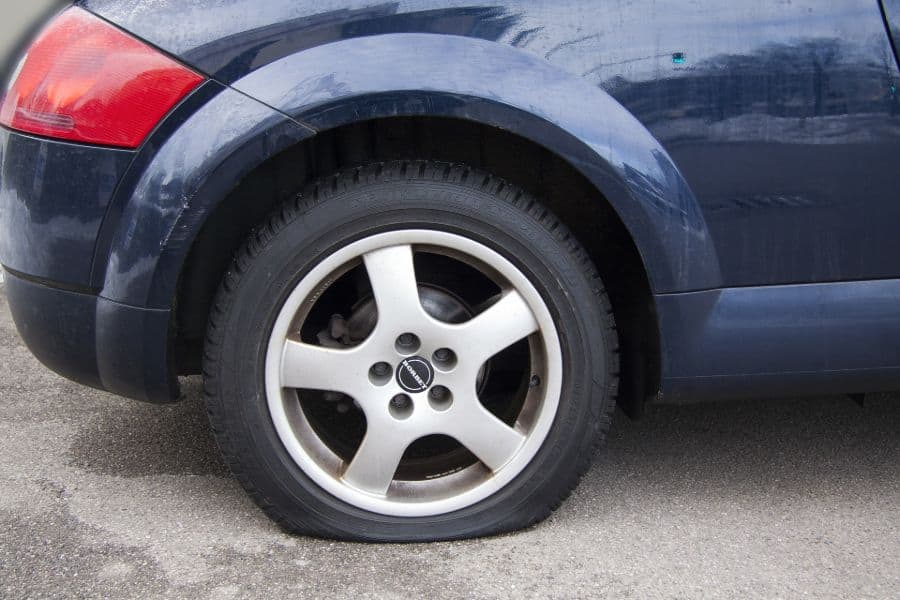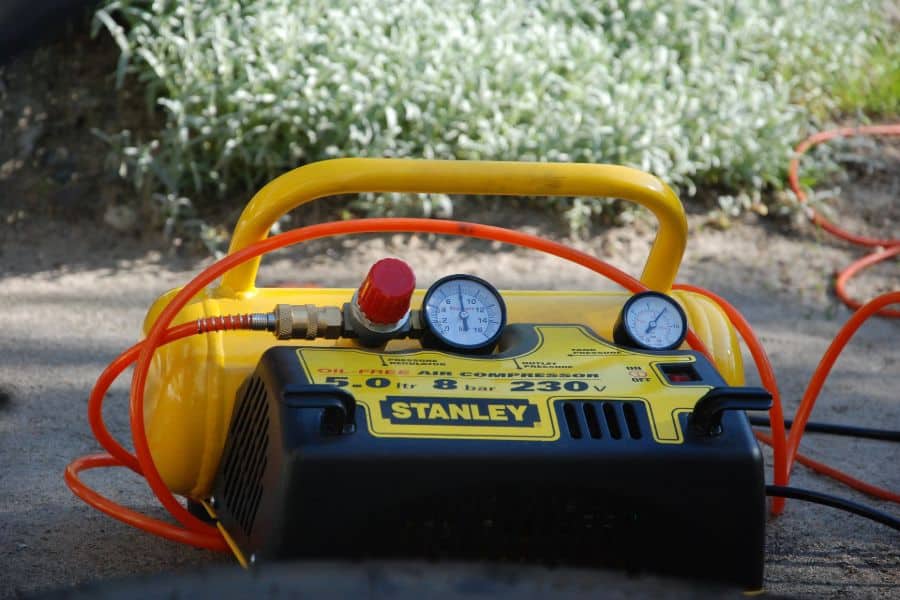Air compressors have a ton of use at home. Most of the time, you’re going to use it for your cars. If you’re planning to get one, you should know how to use air compressor to inflate tires to make better use of it.
Contents
How to Use an Air Compressor for Tires
Compressors make short work of inflating tires. Here are the steps to get your tires up to the proper PSI.

Know Your Car’s Characteristics
Prior knowledge of your car’s properties helps you prepare for any repairs or adjustments should you encounter any mishaps. This knowledge may encompass the general traits below:
Tire Pressure
Before you inflate your tires, know the recommended amount of pressure that your vehicle needs for optimum performance. The most common air pressure metric used for vehicles is pounds per square inch (PSI).
Though modern vehicles usually require around 30-35 PSI, I recommend that you consult the owner’s manual from your vehicle manufacturer for the correct tire pressure.
Do not use the PSI number etched on your tires’ sidewalls. This PSI metric might mislead you as it is used to show the maximum air pressure that your tires can endure. Using this measurement might expose you and your vehicle to blowout and potential injury.
Since 2008, most vehicles have been equipped with a tire-pressure monitoring system (TPMS). This system warns a driver of tire pressure dropping to levels less than 25 percent of the recommended pound per square inch. However, this level of underinflation is as severe as it can hamper normal vehicle use.
You can measure your car tires’ pressure levels through the following method:
- Park your vehicle at a safe location
- Remove the tire valve and place it at a safe and memorable place
- Press the tire gauge firmly onto the valve stem, ensuring there’s no air leakage
- Take the reading on whatever display is available
- Repeat the process 2-3 times to increase the accuracy of your findings
Inflating your tires with less air than is recommended tends to harm your vehicle. Cars running on insufficient air pressure tend to build up heat from the car tires’ sidewalls flexing more than usual. This heat can cause a blowout due to some of the rubber separating from the carcass of the tire, leading to a loss of vehicular control.
Temperature
Most car manufacturers tend to measure vehicles’ air pressure measurement in cooler temperatures. The preference towards cooler temperatures comes from the fact that car tires expand in heat. This expansion causes a higher PSI reading than normal, which works against you when filling your tires.
I recommend that you wait for more than 30 minutes before filling your tire. However, if you must fill now, add 2-3 more pounds per square inch of pressure while the tire is still hot.
Prepare the Tires
Place the air compressor near a tire for ease of access. Remove the stem cap located on the top of the valve stem while ensuring the safety of the stem cap. Do not remove the cap unless you’re planning to use the compressor. The reason for such prudence is to prevent the unnecessary escape of air from the tires.
Know the Tire’s CFM Requirements
When using an air compressor to inflate tires, it’s important to match the compressor’s air flow capacity, measured in cubic feet per minute (CFM), to the size of the tire you need to fill.
For most passenger vehicle tires that are 15 to 17 inches, a compressor with 2 to 3 CFM should be adequate for inflation in a reasonable amount of time. Larger truck tires and equipment tires may need up to 5 CFM or more for quick inflation.
Using a compressor with too low of a CFM rating can mean very slow tire filling, taking 30 minutes or longer to reach proper pressures. Going with too small of an air compressor can lead to frustration when you just need to top off a flat tire and get back on the road.

Inflate Your Tires with an Air Compressor
An average air compressor uses electric power as its power source.
- Power the air compressor on and give it a few minutes to fill with air.
- Take note of the air compressor’s voltage, as using too much voltage can short its circuit, risking damage to the air compressor.
- Using low voltage, on the other hand, might not power on the air compressor at all.
From there, follow these general steps:
- Connect the air chuck to the end of the air hose.
- Remove the valve cap from the tire and attach the air chuck to the valve stem. The valve stem is the small metal part sticking out of the tire that you use to add air.
- Turn on the air compressor and set the pressure to the desired level. You can find the recommended tire pressure for your vehicle in the owner’s manual or on a sticker inside the driver’s side door jamb.
- Monitor the pressure gauge on the air compressor and on the tire pressure gauge. When the tire pressure reaches the desired level, turn off the air compressor and remove the air chuck from the valve stem.
- Replace the valve cap on the tire and move on to the next tire.
The time your air compressor might take filling up the tire depends on its capacity and how much air was already contained in the tire already. Regardless of the type of air pump, you are using, do not step away and go do other things. This measure prevents excess air from entering the tires.
If you’re using your air compressor to fill up bike tires, it will take a lot less time than filling up larger truck tires with an air compressor.
Safety Considerations
When inflating tires, be sure to follow some basic safety precautions.
- Wear protective eyewear in case of blowouts or debris flying out from the tire.
- Stand back several feet from the tire and avoid leaning directly over it as it inflates. Over-inflation can cause sudden tire failure.
- Adhere to recommended pressures and frequently check the gauge during inflation.
- Use a clip-on chuck with a pressure gauge and long hose for added distance from the tire. Don’t leave an inflating tire unattended – stay alert in case quick pressure release is needed.
Taking a few simple safety measures will protect you when pumping air into tires.
Can You Use an Air Compressor to Inflate Car Tires?
Yes, you can use an air compressor to inflate car tires. In fact, using an air compressor is a quick and convenient way to inflate tires, whether they are on a car, truck, motorcycle, or other vehicles.
To use an air compressor for inflating tires, you will need an air compressor with an air hose and pressure quality gauge, a tire pressure gauge, and an air chuck (a device that allows you to connect the air hose to the tire valve).
Tire Pressure Safety
Proper tire inflation pressure is crucial for safe driving. Over or under-inflated tires can negatively impact handling, braking distance, and fuel economy.
- Always refer to the vehicle manufacturer’s recommended pressure listed in the owner’s manual or on a sticker inside the driver’s door jamb.
- Use an accurate pressure gauge while inflating tires, and avoid overinflating beyond the maximum pressure.
- Check pressures at least monthly when tires are cold before driving.
Maintaining inflation within the recommended range will help prevent tire failures, uneven wear, and blowouts that can lead to dangerous situations on the road.
Related Questions
How Much PSI Should A Compressor Have to Fill Tires?
The average PSI for a compressor to fill tires would be around 32 PSI to 35 PSI for passenger cars. It also depends on the temperature. If the tires are cold, the friction generated can increase the pressure.
How Can I Inflate Tires At Home?
Inflating your tires at home with an air compressor is easy. First, set up your compressor and attach the tire nozzle. Check your tire for its recommended PSI, usually on its sidewall. Connect the nozzle, release air into the tire, and monitor the pressure with a gauge. Disconnect when you hit the right PSI.
Do You Just Plug in an Air Compressor?
Yes, you can just plug in an air compressor onto a power outlet. Most of the time, you will plug it into a 3-pronged outlet. Make sure that the switch is turned off before plugging it in.
Conclusion
Low tire pressure and flat tires pose huge disadvantages to you. These disadvantages range from adverse effects on vehicle handling to the risk of encountering an accident. However, there’s a light at the end of the tunnel.
You can use an air compressor to inflate your car tires. I hope the steps I have discussed, from checking your tire pressure and PSI level to inflating your tires, help you in your time of need.
